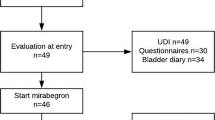Abstract
The cause of ‘female urethral instability’ is still controversial. With the help of this retrospective analysis of 1168 continuous long-term recordings of the intraurethral pressure at the maximum point of urethral pressure, the correlation between pressure variations (UPV) and simultaneous bladder instability was investigated. It could be stated that clinically important UPV (more than 15 cmH2O) are found more often in women who suffer from signs of bladder instability (defined as low bladder compliance combined with uninhibited detrusor contractions and/or urinary leakage) than in patients without signs of unstable bladder.
Similar content being viewed by others
References
v. Fischer E, Dreher E, Locher P. Die instabile Urethra. Gynäk Rdsch 1982; 22 Suppl. 3:84–85
Hindmarsh JR, Gosling PT, Deane AM. Bladder instability. Is the primary defect in the urethra? Br J Urol 1983; 55:648–651
Savitsky AG. Urethral instability in female patients with urinary stress incontinence. Urol Nephrol 1985; 50:28–31
Sorensen S, Norgard JP, Djurhuus JC. Continuous urethral pressure measurements in women with instabile detrusor. Neurourol Urodyn 1986; 5:525–534
Venema PL. De klinische Betekenis van de instabiele Urethra van de vrou. Promotion, Leiden, 1988
Weil A, Miege B, Rottenberg R. et al. Clinical significance of urethral instability. Obstet Gynecol 1986; 68:106–110
Eberhard J. Die Stressinkontinenz der Frau — Auswertung und Interpretation der Urethradruckprofile. Geburtsh Frauenheilk 1979; 39:195–208
Voigt R, Voigt P. Vergleich prä- und postoperativer Befunde nach Stressinkontinenz-Operationen der Frau. Geburtsh Frauenheilk 1981; 41:683–688
Colstrup H, Lose G, Jorgensen L. Is urethral pressure fluctuation observed by use of the Brown-Wickham method an artefact? Third Joint Meeting of ICS and Urodyamics Society, Boston, 17–19 September 1986; 192–194
Hetzenauer A, Baznell A, Rider W. Unstable female urethra: incidence and significance. Proceedings 15th Annual Meeting of International Continence Society, London, 3–6 September 1985; 111–112
Hajdu K, Festge OA. Therapiemöglichkeiten und -eergebnisse bei der instabilen Urethra. IV. Dresdner urodynamisches Kolloquium, Dresden, 21–22 June 1985
Sage S, Kühler B, Wehnert J. Diagnostik und Therapie der instabilen Urethra. IV. Dresdner urodynamisches Kolloqium, Dresden, 21–22 June 1985
Vereecken RL. A comparative study of patients with unstable and stable urethras. 19th Annual Meeting of the International Continence Society, Lubljana, 7–9 September 1989; 142–143
Abid I, Ayed M, Boujnah H. et al. L'instabilite uretrale. J Urol 1987; 93:137–140
Penders L, de Leval J, Petit R. Enuresis and urethral instability. Eur Urol 1984; 10:317–322
Plevnick S, Janez J. Urethral pressure variations. Urology 1983; 21:207–210
Melchior H. Urologische Funktionsdiagnostik. Stuttgart, New York: Thieme, 1981
Abrams P, Blaivas JG, Stanton SL, Andersen JT. The standardization of terminology of lower urinary tract function recommended by the International Continence Society. Int Urogynecol J 1990; 1:45–58
Hebert DB, Ostergard DR. Vesical instability: urodynamic parameters by microtip transducer catheters. Obstet Gynecol 1982; 60:331–337
McGuire EJ. Reflex urethral instability. Br J Urol 1978; 50:200–204
Kulseng-Hansen S, Kristoffersen M. Unstable urethral pressure in females with and without symptoms from the lower urinary tract. Third Joint Meeting of ICS and Urodynamics Society, Boston, 17–19 September 1986; 34
Ulmsten U, Henriksson L, Iosif S. The unstable female urethra. Am J Obstet Gynecol 1982; 144:93–97
Low JA, Armstrong JB, Manger GB. The unstable urethra in the female. Obstet Gynecol 1989; 74:69–74
Bergman A, Koonings PP, Ballard CA. Detrusor instability: is the bladder the cause or the effect? Neurourol Urodyn 1988; 7:186
Author information
Authors and Affiliations
Rights and permissions
About this article
Cite this article
Voigt, R., Halaska, M., John, M. et al. Clinical importance of urethral pressure variations. Int Urogynecol J 3, 129–132 (1992). https://doi.org/10.1007/BF00455089
Issue Date:
DOI: https://doi.org/10.1007/BF00455089




